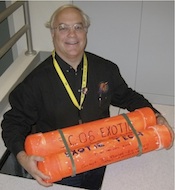In the realm of Rock Stars, there are One-hit Wonders, Divas, Boy Bands, American Idols, Crazy Hearts, and Legends. Our insideHPC Rock Stars are clearly an elite group of industry luminaries and thought leaders, but even among this group, few have attained the legendary status of this month’s insideHPC Rock Star. The old timers in […]
Rock Stars of HPC: John Shalf

This month our Rock Stars of HPC series is featuring LBNL’s John Shalf. John leads the Advanced Technology Group for Lawrence Berkeley National Lab, has authored more than 60 publications in the field of software frameworks and HPC technology, and has been recognized with three best papers and one R&D 100 award.
He also leads the LBNL/NERSC Green Flash project — which is developing a novel HPC system design (hardware and software) for kilometer-scale global climate modeling that is hundreds of times more energy efficient than conventional approaches — and participates in a large number of other activities that range from the DOE Exascale Steering Committee to Program Committee Chair for SC2010 Disruptive Technologies.
Shalf’s energy and dedication to HPC are helping to actively shape the future of HPC, and that’s what makes him this month’s HPC Rock Star.
Rock Stars of HPC: Marc Snir
HPC Rock Star is Marc Snir. During his time at IBM, Snir contributed to one of the most successful bespoke HPC architectures of the past decade, the IBM Blue Gene. He was also a major participant in the effort to create the most successful parallel programming interface ever: MPI. In fact Bill Gropp, another key person in that effort, credits Snir with helping to make it all happen.
Rock Stars of HPC: Thomas Sterling
As part of the team that explored the Beowulf computing concept, Thomas Sterling has already revolutionized the high performance computing community once. But the author of six books and a raft of journal and conference publications isn’t ready to leave the hard work of change to someone else. His sights are set now on changing the way we use and build the supercomputers of today and the exascale monsters of tomorrow.
Rock Stars of HPC: Ricky Kendall
This series is about the men and women who are changing the way the HPC community develops, deploys, and operates the supercomputers we build on behalf of scientists and engineers around the world and Ricky Kendall, this month’s HPC Rock Star, is at the center of enabling science on the largest computing systems the world has ever seen.
 As the leader of the scientific computing group at one of the nation’s leading HPC facilities, Kendall and his team enable users get the most out of what is today the largest supercomputer in the world. But this isn’t a theoretical task for Kendall — he comes from the large scale application development trenches himself, having been part of the team that started NWChem, one of the leading community codes for computational chemistry. Kendall’s accomplishments put him in the center of the computational community. As he puts it, “The chemistry community often sees me as a computer jock, and the computer science community sees me as an applications person.”
As the leader of the scientific computing group at one of the nation’s leading HPC facilities, Kendall and his team enable users get the most out of what is today the largest supercomputer in the world. But this isn’t a theoretical task for Kendall — he comes from the large scale application development trenches himself, having been part of the team that started NWChem, one of the leading community codes for computational chemistry. Kendall’s accomplishments put him in the center of the computational community. As he puts it, “The chemistry community often sees me as a computer jock, and the computer science community sees me as an applications person.”
Kendall is the kind of leader that the HPC community needs most: someone committed to making sure that the systems our community builds end up helping to move the world forward.
Rock Stars of HPC: Bill Kramer
This series is about the men and women who are changing the way the HPC community develops, deploys, and operates the supercomputers we build on behalf of scientists and engineers around the world. That’s why this month’s HPC Rock Star is an especially good choice.
 Bill Kramer has spent his career finding, catalyzing, and managing change in HPC. Early in his career he helped field the first, production Unix-based supercomputer, and he has continued to work to design and commission some of the most innovative and successful computers of the past twenty years: during his career he has fielded twenty large supers, 7 of which have been in the top 5 of the Top500. Kramer’s career choices have always drawn him to our community’s leading organizations, places that were changing something fundamental about what it means to be a supercomputer center. But he isn’t about change just for the sake of change: for Kramer it is a way to make sure that he stays fresh, and does the best job he can for the people he is leading, and for the people who use his systems.
Bill Kramer has spent his career finding, catalyzing, and managing change in HPC. Early in his career he helped field the first, production Unix-based supercomputer, and he has continued to work to design and commission some of the most innovative and successful computers of the past twenty years: during his career he has fielded twenty large supers, 7 of which have been in the top 5 of the Top500. Kramer’s career choices have always drawn him to our community’s leading organizations, places that were changing something fundamental about what it means to be a supercomputer center. But he isn’t about change just for the sake of change: for Kramer it is a way to make sure that he stays fresh, and does the best job he can for the people he is leading, and for the people who use his systems.




